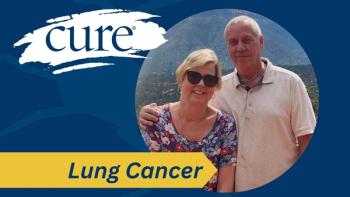
- Summer 2018
- Volume 1
- Issue 1
'Cracking the Nut' on RAS Mutations
Scientists have spent 35 years seeking ways to disable RAS, a gene that’s mutated in many cancer types. Now, they’re moving closer to solutions.
The fact that JOHN MACLEOD'S colorectal cancer expresses a RAS gene mutation has limited his treatment options. - PHOTO BY KONNOR J DURANTE
John MacLeod and his wife were enjoying a trip to Scotland and Ireland late in 2013 — until he began experiencing bowel problems. He figured it was just a result of an unhealthy holiday diet and a few too many of the local libations.
But back at home, the symptoms returned, and his wife, a physician, recommended he see his family doctor. Three days later, he underwent a colonoscopy that found a 7-centimeter tumor, located 15 centimeters in at the junction of his colon and rectum.
“I went home for the longest weekend ever and then had a CT scan on Monday,” recalls the 49-year-old former salesman from North Wales, Pennsylvania. The scan revealed 20 tumors throughout his lungs and liver. MacLeod had stage 4 colorectal cancer (CRC).
Soon after, a gene mutation found in his cancer raised additional concerns.
For one thing, RAS mutations, which occur in nearly half of CRCs, as well as in large percentages of other cancer types, are associated with poorer prognosis. Beyond that, the genetic anomaly meant that, although MacLeod was able to undergo surgery and combination chemotherapy, his cancer would not respond to another available treatment strategy — a class of drugs that targets the protein EGFR (the epidermal growth factor receptor).
That didn’t leave him without options, as radiation was also an approved treatment for stage 4 CRC, as were anti-angiogenic drugs such as Avastin (bevacizumab), which target the blood vessels that feed tumors. Today, immunotherapy is also available as a treatment for some advanced CRCs.
SOLVING A MYSTERY
Yet, no approved drug specifically targets RAS in any cancer type.
RAS was the first human oncogene discovered (such genes, if mutated, can cause cancer), and since then — 1982 — it has remained the most common.
In fact, RAS gene mutations occur in up to 30 percent of all cancers, including about 45 percent of colorectal, 32 percent of lung and nearly all pancreatic cancers. However, although researchers have generated multiple drugs that successfully target other mutations to fight cancer, RAS is also the most elusive when it comes to developing targeted therapies.
That fact is not lost on Frank McCormick, Ph.D., a professor of cellular and molecular pharmacology who has spent his entire career seeking a way to defeat the RAS mutation.
McCormick, who serves at the University of California, San Francisco (UCSF) Helen Diller Family Comprehensive Cancer Center, also directs the National Cancer Institute’s RAS initiative, a huge, collaborative research program begun in 2013 to develop therapies to attack this family of mutations. Given the prevalence of these mutations, his work could add important tools to the treatment landscape for many patients across the spectrum of cancers — meaningful because their options can be quite limited.
For instance, McCormick points out, no trials exist to test treatments specifically on patients with KRAS mutations, and RAS mutations in colorectal cancer can actually exclude patients from some trials, because the medications won’t work or the cancer might progress too rapidly.
Most of the time, a RAS mutation is associated with poorer prognosis precisely because fewer therapeutic options exist. In fact, it may be because nearly all pancreatic cancers have the mutation that it’s such a deadly disease: Without a way to target RAS mutations, doctors cannot fight the cancer’s primary driver, says Channing Der, Ph.D., a professor of pharmacology and microbiology at the University of North Carolina at Chapel Hill.
The role of RAS mutations in non-small cell lung cancer (NSCLC) is less clear, but when CRC spreads to the liver, the disease is more aggressive if it has a KRAS mutation. In patients whose colorectal liver metastases are cured by surgical resection, RAS mutations predict a greater risk of lung recurrence.
RAS mutation status is also frequently associated with another prognostic factor in CRC: the side of the body on which a tumor develops, says Eric Collisson, M.D., an associate professor of medicine at UCSF. People with CRC whose tumors start on the right side are more likely to have KRAS and BRAF mutations — and poorer outcomes, particularly in later-stage disease. It’s not clear why sidedness matters or whether it is much of an issue in earlier stages, but it can affect treatment decisions. Like those with RAS mutations, patients with right-sided tumors are less likely to respond to anti-EGFR treatments.
The bottom line: Progress is badly needed, McMormick says. “The whole pharmaceutical industry is trying to find RAS drugs, and there’s a tremendous push to find them.
TARGETING RAS MUTATIONS
I’m pretty sure there will be several ways of beating RAS in the next few years,” he says. “We’re not quite there yet, but I think we’re cracking the nut. When we started this initiative four years ago, we didn’t have a clear path of what approach would yield first, and now we’re really moving things forward. It’s going to be very difficult, but at least there’s a path ahead.”
The RAS family includes the KRAS, NRAS and HRAS genes; though it’s not known why, KRAS accounts for nearly 90 percent of RAS mutations. The KRAS gene is essential for cell division because it sends signals to a biological on/off switch that tells cells when to start and stop dividing. When the gene is mutated, it creates a misshapen protein that prevents the switch from turning off. The cells never stop dividing, forming a tumor.
Scientists know what the RAS protein looks like and how it behaves in both healthy and cancerous cells, but they haven’t found a way to target it with drugs without disrupting its function in normal cells. The protein’s smooth surface poses a problem.
“RAS is an intracellular protein, so it’s not on the cell surface, and it doesn’t have an active site drugs can bind to,” McCormick says. “It’s like a tennis ball. Imagine finding something to attach to a tennis ball when there’s no hole or pocket to bind to.”
As a result, scientists have to think outside the box. “Currently, there are at least five major ways that the cancer research community is trying to tackle this problem,” Der says. “One is a direct attack to find something to specifically cripple the mutant RAS proteins. Until recently, that was thought to be an impossible task, but rather surprisingly, we’ve actually made some progress toward a direct attack on RAS itself.” The first direct RAS inhibitor, developed by San Diego-based Mirati Therapeutics, is expected to enter clinical trials in 2019.
The main approaches, Der says, are indirect, such as targeting the pathway along which the signal travels to switch the protein on or off. More than a dozen genes control the chain of proteins along the signaling pathway, which include RAF, MAPK, MEK and ERK.
“If we can sever the wires between RAS and the nucleus, that can do a pretty good job of blocking RAS’s ability to drive cancer, but the problem is that it’s not just one wire,” Der says. “The question is, how many wires do we need to cut?”
Scientists are making progress on therapies targeting this pathway for melanoma, which has almost solely NRAS mutations, but KRAS has proved trickier. “There are drugs that inhibit RAF and MEK and ERK to block RAS signaling, but they haven’t (entirely) worked for two reasons,” McCormick says. “One is the fundamental problem that the same pathway is essential to every cell in the body to respond to signals and to grow and survive.”
Since the pathway is essentially the same in both cancer and healthy cells, shutting it down could be too toxic, interrupting the growth of healthy cells.
“The other problem is that, when you start blocking the pathway, the cell finds ways to compensate,” McCormick says. “It’s not a simple relay. It’s a complicated network, so it’s very hard to shut it down.”
McCormick is involved with another San Diego-based company, Wellspring Biosciences, that will head to clinical trials soon with “a small-molecule drug that binds to one specific path of the protein, which is different between the oncogenic and normal protein,” he says.
The drug, ARS-1620, shrank tumors in mice in a January 2018 study by freezing one mutant form of the protein made by KRAS, called G12C, in its inactive state. The G12C mutant form occurs in about 16 percent of NSCLCs but just 1 to 4 percent of pancreatic and colorectal cancers, so this may be an effective therapy for a significant fraction of lung cancers, the No. 1 cause of cancer deaths in the U.S.
Another approach, Der says, involves cutting the wires above RAS so that the protein dislodges from the plasma membrane and can’t send signals downstream. Again, however, this approach could risk too much toxicity if the wiring to healthy cells is cut, too.
KEEPING OPTIMISM HIGH
An additional approach involves starving cancer cells that have the RAS mutation by denying them nutrients, and a final strategy relies on a concept called synthetic lethality, in which scientists look for genes that are nonessential in healthy cells but essential in mutant RAS cells. If they can find one, they might be able to target RAS-mutant cells without harming healthy ones.
MacLeod underwent eight rounds of FOLFOX chemotherapy, a combination of fluorouracil (5-FU) with Eloxatin (oxaliplatin), at the University of Pennsylvania, followed by liver and colon surgery in May 2014 at the University of Pittsburgh Medical Center that left his abdomen cancerfree. He also took Avastin. “Anti-angiogenesis is a staple of (metastatic) colon cancer treatments in the first and second line and has been shown to benefit all patients,” regardless of mutation status, Collisson says.
After that operation, MacLeod continued the FOLFOX regimen and then, in September 2014, underwent more lung surgery. When he developed neuropathy during his next round of FOLFOX, his doctor substituted Camptosar (irinotecan) for Eloxatin — known as the FOLFIRI regimen.
Next, “We began looking at clinical trial options,” McLeod says. He turned to a trial testing immunotherapy on cancers with a high level of microsatellite instability (MSI), which refers to how well a tumor can repair its mutated DNA each time cells divide. High instability — an accumulation of errors — “ironically makes it easier to treat because it makes (the cancer) immunotherapy sensitive,” Collisson says.
About 15 percent of colorectal cancers are MSI-high, and the Food and Drug Administration approved the immunotherapy drug Opdivo (nivolumab) last year for these cancers. Immunotherapy in general remains an option for people with RAS mutations who are seeking clinical trials.
That said, many with RAS-mutated CRC have microsatellite-stable cancer, and MacLeod is one of them. He was nevertheless able to participate in the trial that tested immunotherapy largely on MSI-high patients, but taking Keytruda (pembrolizumab) for seven months left him with a severe lung inflammation, pneumonitis.
MacLeod has joined two other clinical trials and will start a fourth soon at the National Institutes of Health. His liver stayed cancer-free for about two years before tumors returned there and in his lungs. Across the treatments he’s tried, not much has really worked, he says.
MacLeod remains optimistic and active, golfing several times a week and regularly swimming in his pool. He runs a CRC boot camp and encourages participants to take advantage of social media support resources but avoid reading reported survival rates — they’re outdated the moment they’re published, he says.
“Life is going to change in a lot of ways, but it’s in no way a death sentence,” he says. “Anything they can treat, I take the treatment and get all of it they can give. If they can’t, I’m at the golf course or the pool. I’m going to live my life.”
As MacLeod leapfrogs from trial to trial — ideally, giving himself more time with each one — he’s betting that the prevalence of RAS mutations will be an impetus for research that leads to effective treatments. “The KRAS mutation is very common,” he says, “so now that people have gone to focusing on cancer at the genetic level, let’s hope that capitalism kicks in.” Researchers like Der, who has focused on RAS since the day it was discovered, also remain hopeful. “If we’re going to tackle what clearly is a rewarding but tough issue,” he says, “we certainly need to be very optimistic and determined.”
Articles in this issue
over 7 years ago
A Starting Player for the Houston Texans Is Facing Blood Cancerover 7 years ago
Whimsical Wigs Bring Smiles to Children Undergoing Treatmentover 7 years ago
Presence of Mind: Tips for Combatting Chemo Brainover 7 years ago
Life Lessons from Mr. Rogersover 7 years ago
Comments From Our Readers on the Summer 2018 Issueover 7 years ago
Financial Healing From Cancerover 7 years ago
Robin Roberts: Making Her Mess Her Messageover 7 years ago
Former Vice President Joe Biden Encourages Teen During Treatment




